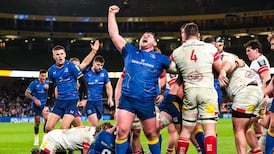‘We’ve got to be honest, we need a big improvement,” said one coach. We all know what happened on the scoreboard but how good were the victors? When a vastly depleted Ireland reached sufficient pace, Scotland looked extremely vulnerable. The other coach stated that we must “learn how to finish out tight matches”. Seriously, was this a tight match? Even with all the injuries Ireland faced my heart sank as it should never have come to that.
A coaching ticket cobbled together to give direction and confidence has achieved enormously for Scotland and they and their players deserve huge credit. But what of Ireland? Last Friday’s article was based on weaknesses contained deep inside Scotland, much of which came to fruition, such as one up missed tackles in midfield and the Scottish breakdown, which was meek. Nothing I saw yesterday has changed my mind. In this environment of total dominance your generals manufacture the scores – ours didn’t.
Scotland’s set-piece, however, was magnificent and requires immediate reaction from Ireland. The first scrum penalty came deep inside Scotland’s 22 where Seán O’Brien slipped up off Tom Court’s rear, depowering Court. This was not as costly as the scrum penalty conceded outside our 22 on 58 minutes. Ten minutes earlier Ireland won a scrum penalty when the Irish backrow were totally committed. But on 58 minutes Scotland got a slight eight-man nudge on our put in and both Irish flankers slipped off their props, making them vulnerable. The score shifted from six points to nine with the energy swinging to Scotland. No amount of ball-carrying can make up for this loss of backrow concentration.
Lineout struggled
The hitherto peerless Rory Best struggled at lineout time, where it is never easy to find your target against the beanpoles of Scotland. More’s the pity as our lineout maul was much steadier, solid and patient in its make up than Scotland’s and could have reaped reward had the ball found its target. It reflects poorly on Seán Cronin as he was not introduced.
Countless times Ireland did damage Scotland but it took till the 43rd minute to put real pace on multi-phases. O’Brien, who had a mighty match ball in hand, slipped past Ross Ford for open territory. Deep inside Scotland’s half he crucially managed brilliant ball placement to afford Conor Murray an immediate whip away, which eventually brought Rob Kearney on to a straight line, which Sean Lamont failed entirely to defend. Ford, having worked very hard to get back on his try line once again, missed his tackle, allowing Craig Gilroy’s beautiful pirouette try. Pretty simple: pace, sharp breakdown and hard running which Scotland couldn’t cope with. Why not more often?
Inside Lamont was Matt Scott, whose exuberance to lead the line in defence pulled him out of shape, which Luke Marshall initially exploited, especially on six minutes. In carrying with both hands with decoy runners he put sufficient doubt in the Scottish defence to cause confusion and in those moments he scampered through. Strangely, Ireland didn’t consistently attack these weaknesses. Scotland made 128 tackles but missed 16 (Ireland four) and had Ireland been more clinical they would have scored; but they didn’t and in leaving them off the hook afforded Scotland the chance to keep working, which they did, deserving huge credit.
The breakdown was completely dominated by Ireland’s 106 vs Scotland’s 29 ruck clearance. On 49 minutes Rob Harley got over the tackled Kearney to steal the ball but Jamie Heaslip arrived and simply peeled him away. Unfortunately Ireland’s hunger for turnovers and counter-rucks led to penalties. But as the phases were being built Scotland once again stayed disciplined where Ireland needed to keep pace on the time between ball-carrier entering contact and scrumhalf whipping away. Ireland eked little reward from their multi-phase plays, especially with Scotland down to 14 men.
Drop goals vs multi-phase
This is where tactical decisions come into play. Subconsciously, how did Paddy Jackson’s presence on the pitch guide Heaslip’s decision-making to avoid early three-pointers? Three-points vs five; drop goals vs multiphase; keep the board ticking over, especially away from home, and especially against a side that needed to be killed off before they came to life. Ireland didn’t gain return from each visit into Scotland’s 22.
Jackson looked for narrow targets off the blindside winger or O’Brien followed by Marshall carrying. When you don’t have the ball you don’t make errors, but you struggle to score tries. Scotland chose to fill the field in defence and, when getting the ball, box-kicked supremely to get out of their half. The quality of Scottish box kicks forced a brilliant aerial display from Gilroy. Ireland ended up playing much of their rugby too far from the Scottish line, where Jackson’s naivety searched for the jugular too far out.
As for performances, Scotland’s front five were immense. Individually, O’Brien was brilliant ball in hand but Brian O’Driscoll was immense in his support lines and his selfless clearing of rucks. The real performance is that of an Ireland coach who can’t justify the loss in learning to how to finish out tight matches. Three of his four provinces would have.












